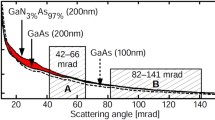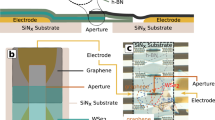Abstract
A methodology for the quantitative compositional characterization of nickel silicides by high angle annular dark field scanning transmission electron microscopy (HAADF-STEM) imaging is presented. HAADF-STEM images of a set of nickel silicide reference samples Ni3Si, Ni31Si12, Ni2Si, NiSi and NiSi2 are taken at identical experimental conditions. The correlation between sample thickness and HAADF-STEM intensity is discussed. In order to quantify the relationship between the experimental Z-contrast intensities and the composition of the analysed layers, the ratio of the HAADF-STEM intensity to the sample thickness or to the intensity of the silicon substrate is determined for each nickel silicide reference sample. Diffraction contrast is still detected on the HAADF-STEM images, even though the detector is set at the largest possible detection angle. The influence on the quantification results of intensity fluctuations caused by diffraction contrast and channelling is examined. The methodology is applied to FUSI gate devices and to horizontal TFET devices with different nickel silicides formed on source, gate and drain. It is shown that, if the elements which are present are known, this methodology allows a fast quantitative 2-dimensional compositional analysis.







Similar content being viewed by others
References
Maex K, Van Rossum M (1995) Properties of metal silicides. INSPEC, London
Maex K (1993) Mater Sci Eng R11:53
Kittl JA, Lauwers A, van Dal MJH, Yu H, Veloso A, Hoffmann T, Pawlak MA, Demeurisse C, Kubicek S, Niwa M, Vrancken C, Absil P, Biesemans S (2006) ECS Trans 3:233
Kittl JA, O’Sullivan BJ, Kaushik VS, Lauwers A, Pawlak MA, Hoffmann T, Demeurisse C, Vrancken C, Veloso A, Absil P, Biesemans S (2007) Appl Phys Lett 90:032103
Gambino JP, Colgan EG (1998) Mater Chem Phys 52:99
Lavoie C, d`Heurle FM, Detavernier C, Cabral C (2003) Microelectron Eng 70:144
Shiojiri M, Yamazaki T (2003) Jeol News 38(2):54
Watanabe K, Yamazaki T, Kikuchi Y, Kotaka Y, Kawasaki M, Hashimoto I, Shiojiri M (2001) Phys Rev B 63:085316
Verleysen E, Bender H, Schryvers D, Vandervorst W (2010) J Phys Conf Ser 209:012057
Verleysen E, Bender H, Richard O, Schryvers D, Vandervorst W (2010) J Microsc 240:75. doi:10.1111/j.1365-2818.2010.03391.x
Pennycook SJ, Nellist PD (1999) Impact of electron microscopy on materials research. Kluwer Academic, Dordrecht
Pennycook SJ, Jesson DE (1991) Ultramicroscopy 37:14
Bonney LA (1990) In: Proceedings of the XIIth international congress for electron microscopy. San Francisco Press, San Francisco, p 74
Egerton RF (1986) Electron energy loss spectroscopy in the electron microscope. Plenum Press, New York
Meltzman H, Kauffmann Y, Thangadurai P, Drozdov M, Baram M, Brandon D, Kaplan WD (2009) J Microsc 236:165
Leonelli D, Vandooren A, Rooyackers R, Verhulst AS, De Gendt S, Heyns MM, Groeseneken G (2009) In: Extended abstracts solid state devices and materials conference, p 767
Leonelli D, Vandooren A, Rooyackers R, Verhulst AS, De Gendt S, Heyns MM, Groeseneken G (2010) Jpn J Appl Phys 49:04DC10
Verhulst AS, Vandenberghe WG, Leonelli D, Rooyackers R, Vandooren A, De Gendt S, Heyns MM, Groeseneken G (2009) ECS Trans 25:455
Verhulst AS, Sorée B, Leonelli D, Vandenberghe WG, Groeseneken G (2010) J Appl Phys 107:024518
Cliff G, Lorimer GW (1975) J Microsc 103:203
Williams DB, Carter CB (1996) Transmission electron microscopy. Plenum Press, New York
Acknowledgements
The authors would like to thank Daniele Leonelli (Imec, Leuven) for providing the TFET structures, Lars-Ake Ragnarsson (Imec, Leuven) for the FUSI structures, Jo Verbeeck (EMAT, Universiteit Antwerpen) for HAADF-STEM measurements with the JEOL 3000F microscope, Paola Favia (Imec, Leuven) for discussion on the STEM analysis and DM software, and Patricia Van Marcke (Imec, Leuven) for sample preparations.
Author information
Authors and Affiliations
Corresponding author
Rights and permissions
About this article
Cite this article
Verleysen, E., Bender, H., Richard, O. et al. Compositional characterization of nickel silicides by HAADF-STEM imaging. J Mater Sci 46, 2001–2008 (2011). https://doi.org/10.1007/s10853-010-5191-z
Received:
Accepted:
Published:
Issue Date:
DOI: https://doi.org/10.1007/s10853-010-5191-z




